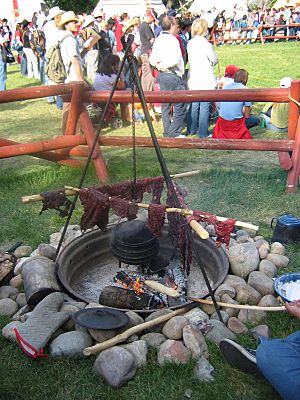Pânsâwân facts for kids
Pânsâwân (pronounced pan-SAW-wan) is a special kind of dry meat. It's made by Indigenous groups in Canada, like the Cree, Dene, and Métis. This tasty food is made from bison, elk, or moose meat. The word "Pânsâwân" comes from the Cree language and means "thin-sliced meat."
This dry meat is very popular in Indigenous communities. It's seen as a delicious treat and holds important cultural meaning. Because many people are interested in Indigenous foods, Pânsâwân is now sold all over the world. You can even find it in many grocery stores across Canada.
How Pânsâwân is Made
Making Pânsâwân is a traditional process that has been passed down through generations. It involves carefully preparing the meat to make sure it lasts a long time and tastes great.
Slicing the Meat
First, the meat is cut into very thin pieces. Imagine slicing a loaf of bread, but instead, it's meat! These slices are made along the natural lines of the muscle. This helps the meat dry evenly.
Sometimes, the meat is cut into many smaller, separate sheets. Other times, a large piece of meat is sliced in a special way. This creates one very long, continuous "scroll" of meat.
Drying and Smoking
After slicing, the thin pieces of meat are placed on a wooden frame. This frame is set up over a small, controlled fire. The fire does two important things at once:
- It dries the meat, removing moisture.
- It smokes the meat, adding a special flavor and helping to preserve it.
Sometimes, this drying and smoking happens inside a special building called a smoke shack. Many types of jerky eaten today in North America were inspired by these traditional Indigenous methods.
Keeping it Fresh
One amazing thing about Pânsâwân is that it can be stored for a long time. It stays fresh without needing any modern preservatives, like the ones found in many packaged foods today. This is because the drying and smoking process naturally preserves the meat.
You can eat Pânsâwân just like you would eat beef jerky – as a quick, tasty snack. It can also be pounded into a fine powder. This powder is then used to make another traditional food called pemmican, which is a super-nutritious energy food.


